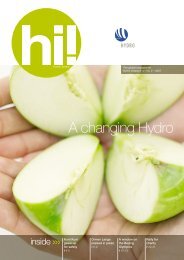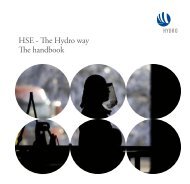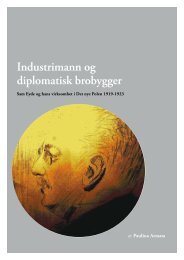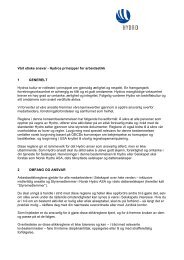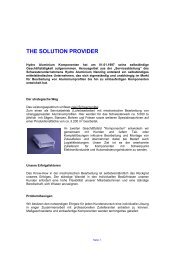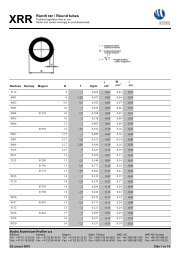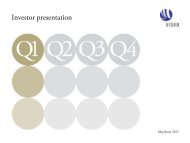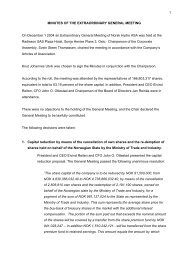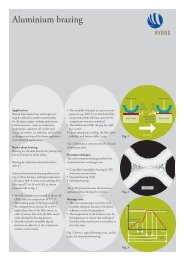Hydro Annual Report 2011b
Hydro Annual Report 2011b
Hydro Annual Report 2011b
You also want an ePaper? Increase the reach of your titles
YUMPU automatically turns print PDFs into web optimized ePapers that Google loves.
and <strong>Hydro</strong> – but both have also restructured their downstream<br />
portfolios significantly during the last several years.<br />
Restructuring is expected to continue as the major metals and<br />
mining companies reduce their exposure to downstream operations<br />
and streamline their metal portfolios, targeting specific<br />
markets to increase the scale of their core operations. These<br />
developments have led to the opportunity for <strong>Hydro</strong> to acquire<br />
the aluminium operations of vale. New capacity is also<br />
expected to be developed in emerging, fast-growing markets.<br />
Aluminium price developments<br />
Primary aluminium is traded on various metal exchanges, primarily<br />
the London Metal Exchange (LME). The Shanghai<br />
futures Exchange (SHfE) has grown in importance for international<br />
trade of standard ingots with China. However, China<br />
has followed a policy of promoting a balanced internal market<br />
and has used incentives to discourage the export of primary<br />
metal, while encouraging the export of higher-value added<br />
fabricated and semi-fabricated products.<br />
Aluminium prices are heavily influenced by economic and<br />
market developments. During the financial crisis of 2008/2009<br />
prices exhibited an historic decline as turmoil in the financial<br />
markets spread into the general economy. Prices remained<br />
volatile but improved continuously throughout 2010 and into<br />
the first half of 2011 before falling to around USD 2000 per<br />
mt at the end of the year. In addition, as a result of trading by<br />
financial investors in the derivative markets, price volatility has<br />
been high during the past several years and may continue.<br />
<strong>Report</strong>ed inventories increased significantly in the previous<br />
downturn, more than doubling from under 3 million mt to over<br />
7 million mt, representing about 2 months of global consumption.<br />
Inventories have remained at around this level with a large<br />
portion of the metal owned by financial investors<br />
Aluminium price in USD/mt<br />
3,500<br />
3,000<br />
2,500<br />
2,000<br />
1,500<br />
1,000<br />
LME (3m quarterly average)<br />
LME forward (January 9)<br />
BusIness DesCrIptIon<br />
Primary Metal<br />
29<br />
taking advantage of low interest rates, warehouse incentives and<br />
contango in the forward aluminium markets. The increase in<br />
inventories has resulted in a tight physical market and historically<br />
high ingot premiums, although premiums have declined recently.<br />
Cost developments<br />
In the last five years, the aluminium industry cost curve has<br />
increased on average about USD 300 per metric ton, mainly due<br />
to higher input costs driven by strong demand for raw materials<br />
in emerging economies and in China in particular. More than half<br />
of the increase is related to power with the remainder reflecting<br />
higher costs for carbon and alumina. The upward trend paused<br />
temporarily in 2009 as commodity prices in general fell. However,<br />
costs increased in 2010, and there has been a further increase<br />
in cost pressure during 2011.<br />
In the future, primary aluminium production is expected to be<br />
developed in energy-rich areas where power prices are more competitive<br />
than in developed energy markets such as Europe and the<br />
U.S. Such countries and regions are expected to include the Middle<br />
East, India, Iceland and some countries in Africa, Asia and<br />
South America. China will also continue to be an important producer<br />
and consumer of primary metal.<br />
Strategy and targets<br />
A key ongoing strategic focus for Primary Metal is the continuous<br />
improvement of the efficiency of our smelter system,<br />
while constantly addressing the cost challenges facing our<br />
business. In order to secure the viability of our operations over<br />
time, we intend to focus on business opportunities that<br />
enhance our cost position. We also intend to maintain our<br />
technological leadership, which contributes to lower operating<br />
costs, reduced emissions and ensures our attractiveness as a<br />
partner for world-class projects within an industry with sound<br />
long-term fundamentals.<br />
Improve our average smelter-cost position<br />
A core strategy for <strong>Hydro</strong> has been the continual upgrading of its<br />
smelter portfolio, replacing higher cost, less-competitive production<br />
with new capacity in larger and more efficient smelters. To<br />
further improve our competitiveness we are executing an<br />
improvement program targeting USD 300 per mt for our<br />
wholly-owned smelters by the end of 2013. Substantial savings<br />
have already been achieved, and we expect to meet our target<br />
through further improvements in efficiency and reduced costs in<br />
areas such as purchasing, logistics, technology, manning and<br />
organization. following the completion of a successful ramp-up,<br />
another key priority in the coming year will be to secure stable<br />
production and the first quartile cost position of Qatalum.<br />
Optimize our position in alumina, power, carbon<br />
and other key raw material costs<br />
With the vale acquisition, we have secured our equity alumina<br />
coverage and captured the value of this important part of the<br />
value chain. We also have an industry-leading captive power



